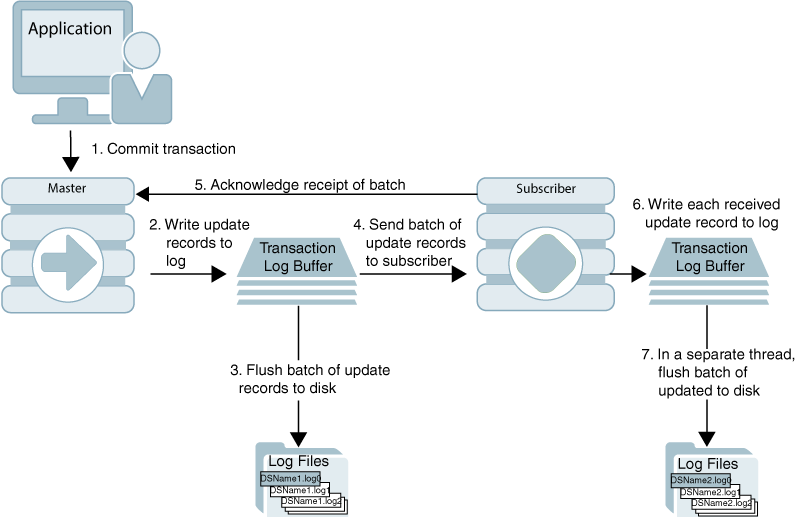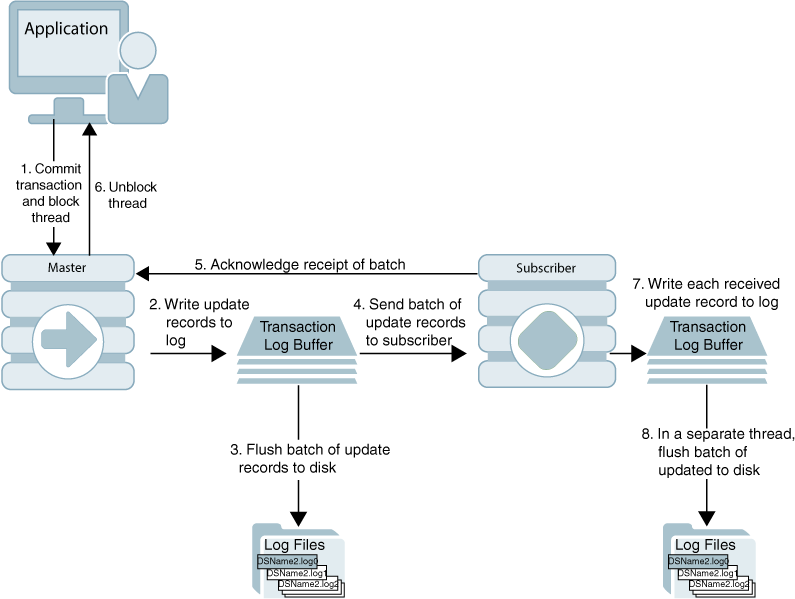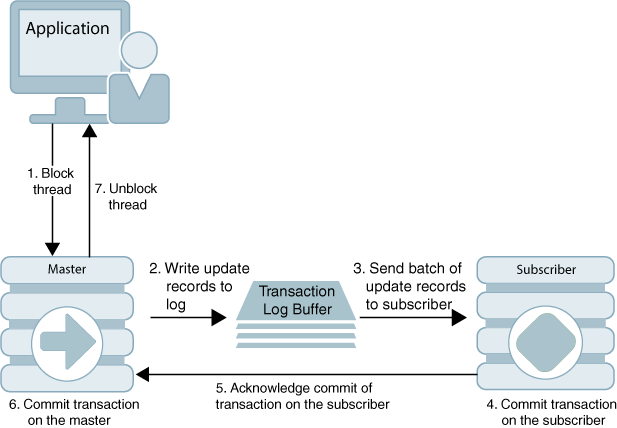Copying Updates Between Databases
By default, updates are copied between databases asynchronously.
While asynchronous replication provides the best performance, it does not provide the application with confirmation that the replicated updates were committed on subscriber databases. For applications that need higher levels of confidence that the replicated data is consistent between the master and subscriber databases, you can enable either return receipt or return twosafe service.
-
The return receipt service loosely synchronizes the application with the replication mechanism by blocking the application until replication confirms that the update has been received by the subscriber.
-
The return twosafe service provides a fully synchronous option by blocking the application until replication confirms that the update has been both received and committed on the subscriber before being committed on the master.
Return receipt replication impacts performance less than return twosafe, but at the expense of less synchronization. The operational details for asynchronous, return receipt, and return twosafe replication are discussed in these sections:
Default Replication
When using default TimesTen Classic replication, an application updates a master database and continues working without waiting for the updates to be received and applied by the subscribers.
The master and subscriber databases have internal mechanisms to confirm that the updates have been successfully received and committed by the subscriber. These mechanisms ensure that updates are applied at a subscriber only once, but they are completely independent of the application.
Default TimesTen Classic replication provides maximum performance, but the application is completely decoupled from the receipt process of the replicated elements on the subscriber.
Figure 1-1 Basic Asynchronous Replication Cycle

Description of "Figure 1-1 Basic Asynchronous Replication Cycle"
The default TimesTen Classic replication cycle is:
-
The application commits a local transaction to the master database and is free to continue with other transactions.
-
During the commit, the TimesTen daemon writes the transaction update records to the transaction log buffer.
-
The replication agent on the master database directs the daemon to flush a batch of update records for the committed transactions from the log buffer to a transaction log file. This step ensures that, if the master fails and you need to recover the database from the checkpoint and transaction log files, the recovered master contains all the data it replicated to the subscriber.
-
The master replication agent forwards the batch of transaction update records to the subscriber replication agent, which applies them to the subscriber database. Update records are flushed to the file system and forwarded to the subscriber in batches of 256K or less, depending on the master database's transaction load. A batch is created when there is no more log data in the transaction log buffer or when the current batch is roughly 256K bytes.
-
The subscriber replication agent sends an acknowledgement back to the master replication agent that the batch of update records was received. The acknowledgement includes information on which batch of records the subscriber last flushed to the file system. The master replication agent is now free to purge from the transaction log the update records that have been received, applied, and flushed to the file system by all subscribers and to forward another batch of update records, while the subscriber replication agent asynchronously continues on to Step 6.
-
The replication agent at the subscriber updates the database and directs the daemon to write the transaction update records to the transaction log buffer.
-
The replication agent at the subscriber database uses a separate thread to direct the daemon to flush the update records to a transaction log file.
Return Receipt Replication
The return receipt service provides a level of synchronization between the master and a subscriber database by blocking the application after commit on the master until the updates of the committed transaction have been received by the subscriber.
An application requesting return receipt updates the master database in the same manner as in the basic asynchronous case. However, when the application commits a transaction that updates a replicated element, the master database blocks the application until it receives confirmation that the updates for the completed transaction have been received by the subscriber.
Return receipt replication trades some performance in order to provide applications with the ability to ensure higher levels of data integrity and consistency between the master and subscriber databases. In the event of a master failure, the application has a high degree of confidence that a transaction committed at the master persists in the subscribing database.
Figure 1-2 shows that the return receipt replication cycle is the same as shown for the basic asynchronous cycle in Figure 1-1, only the master replication agent blocks the application thread after it commits a transaction (Step 1) and retains control of the thread until the subscriber acknowledges receipt of the update batch (Step 5). Upon receiving the return receipt acknowledgement from the subscriber, the master replication agent returns control of the thread to the application (Step 6), freeing it to continue processing transactions.
If the subscriber is unable to acknowledge receipt of the transaction within a configurable timeout period (default is 10 seconds), the master replication agent returns a warning stating that it did not receive acknowledgement of the update from the subscriber and returns control of the thread to the application. The application is then free to commit another transaction to the master, which continues replication to the subscriber as before.
Return receipt transactions may time out for many reasons. The most likely causes for timeout are the network, a failed replication agent, or the master replication agent may be so far behind with respect to the transaction load that it cannot replicate the return receipt transaction before its timeout expires. See Setting the Return Service Timeout Period and RETURN RECEIPT.
Return Twosafe Replication
The return twosafe service provides fully synchronous replication between the master and subscriber.
Unlike the previously described replication modes, where transactions are transmitted to the subscriber after being committed on the master, transactions in twosafe mode are first committed on the subscriber before they are committed on the master.
The following describes the replication behavior between a master and subscriber configured for return twosafe replication:
-
The application commits the transaction on the master database.
-
The master replication agent writes the transaction records to the log and inserts a special pre-commit log record before the commit record. This pre-commit record acts as a place holder in the log until the master replication receives an acknowledgement that indicates the status of the commit on the subscriber.
Note:
Transmission of return twosafe transactions is non-durable, so the master replication agent does not flush the log records to the file system before sending them to the subscriber, as it does by default when replication is configured for asynchronous or return receipt replication.
-
The master replication agent transmits the batch of update records to the subscriber.
-
The subscriber replication agent commits the transaction on the subscriber database.
-
The subscriber replication agent returns an acknowledgement back to the master replication agent with notification of whether the transaction was committed on the subscriber and whether the commit was successful.
-
If the commit on the subscriber was successful, the master replication agent commits the transaction on the master database.
-
The master replication agent returns control to the application.
If the subscriber is unable to acknowledge commit of the transaction within a configurable timeout period (default is 10 seconds) or if the acknowledgement from the subscriber indicates the commit was unsuccessful, the replication agent returns control to the application without committing the transaction on the master database. The application can then to decide whether to unconditionally commit or retry the commit. You can optionally configure your replication scheme to direct the master replication agent to commit all transactions that time out.
See RETURN TWOSAFE.

